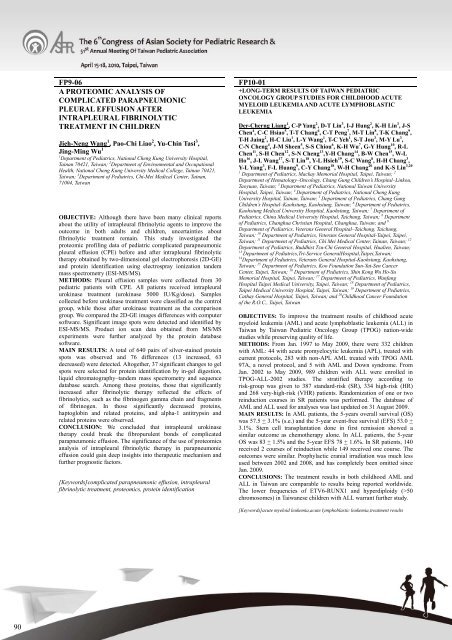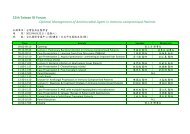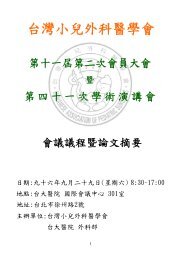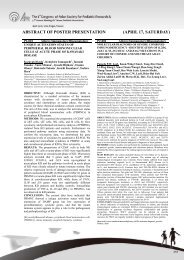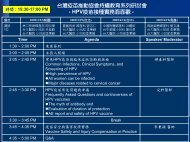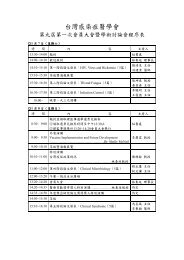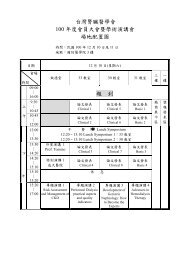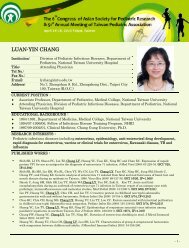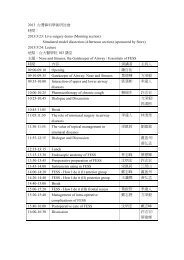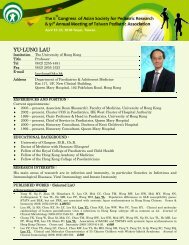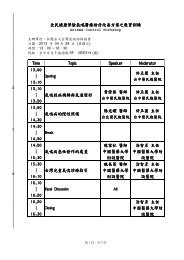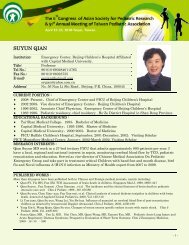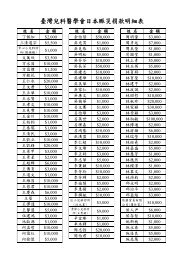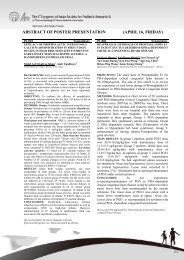ABSTRACT OF INVITED LECTURES AND ORAL PRESENTATION
ABSTRACT OF INVITED LECTURES AND ORAL PRESENTATION
ABSTRACT OF INVITED LECTURES AND ORAL PRESENTATION
- No tags were found...
You also want an ePaper? Increase the reach of your titles
YUMPU automatically turns print PDFs into web optimized ePapers that Google loves.
FP9-06A PROTEOMIC ANALYSIS <strong>OF</strong>COMPLICATED PARAPNEUMONICPLEURAL EFFUSION AFTERINTRAPLEURAL FIBRINOLYTICTREATMENT IN CHILDRENJieh-Neng Wang 1 , Pao-Chi Liao 2 , Yu-Chin Tasi 3 ,Jing-Ming Wu 11 Department of Pediatrics, National Cheng Kung University Hospital,Tainan 70421, Taiwan; 2 Department of Environmental and OccupationalHealth, National Cheng Kung University Medical College, Tainan 70421,Taiwan; 3 Department of Pediatrics, Chi-Mei Medical Center, Tainan,71004, TaiwanOBJECTIVE: Although there have been many clinical reportsabout the utility of intrapleural fibrinolytic agents to improve theoutcome in both adults and children, uncertainties aboutfibrinolytic treatment remain. This study investigated theproteomic profiling data of pediatric complicated parapneumonicpleural effusion (CPE) before and after intrapleural fibrinolytictherapy obtained by two-dimensional gel electrophoresis (2D-GE)and protein identification using electrospray ionization tandemmass spectrometry (ESI-MS/MS).METHODS: Pleural effusion samples were collected from 30pediatric patients with CPE. All patients received intrapleuralurokinase treatment (urokinase 5000 IU/Kg/dose). Samplescollected before urokinase treatment were classified as the controlgroup, while those after urokinase treatment as the comparisongroup. We compared the 2D-GE images differences with computersoftware. Significant image spots were detected and identified byESI-MS/MS. Product ion scan data obtained from MS/MSexperiments were further analyzed by the protein databasesoftware.MAIN RESULTS: A total of 640 pairs of silver-stained proteinspots was observed and 76 differences (13 increased, 63decreased) were detected. Altogether, 37 significant changes to gelspots were selected for protein identification by in-gel digestion,liquid chromatography–tandem mass spectrometry and sequencedatabase search. Among these proteins, those that significantlyincreased after fibrinolytic therapy reflected the effects offibrinolytics, such as the fibrinogen gamma chain and fragmentsof fibrinogen. In those significantly decreased proteins,haptoglobin and related proteins, and alpha-1 antitrypsin andrelated proteins were observed.CONCLUSION: We concluded that intrapleural urokinasetherapy could break the fibropurulent bonds of complicatedparapneumonic effusion. The significance of the use of proteomicsanalysis of intrapleural fibrinolytic therapy in parapneumoniceffusion could gain deep insights into therapeutic mechanism andfurther prognostic factors.[Keywords]complicated parapneumonic effusion, intrapleuralfibrinolytic treatment, proteomics, protein identificationFP10-01+LONG-TERM RESULTS <strong>OF</strong> TAIWAN PEDIATRICONCOLOGY GROUP STUDIES FOR CHILDHOOD ACUTEMYELOID LEUKEMIA <strong>AND</strong> ACUTE LYMPHOBLASTICLEUKEMIADer-Cherng Liang 1 , C-P Yang 2 , D-T Lin 3 , I-J Hung 2 , K-H Lin 3 , J-SChen 4 , C-C Hsiao 5 , T-T Chang 6 , C-T Peng 7 , M-T Lin 8 , T-K Chang 9 ,T-H Jaing 2 , H-C Liu 1 , L-Y Wang 1 , T-C Yeh 1 , S-T Jou 3 , M-Y Lu 3 ,C-N Cheng 4 , J-M Sheen 5 , S-S Chiou 6 , K-H Wu 7 , G-Y Hung 10 , R-LChen 11 , S-H Chen 12 , S-N Cheng 13 ,Y-H Chang 14 , B-W Chen 15 , W-LHo 16 , J-L Wang 17 , S-T Lin 18 , Y-L Hsieh 19 , S-C Wang 8 , H-H Chang 3 ,Y-L Yang 3 , F-L Huang 9 , C-Y Chang 18 , W-H Chang 20 and K-S Lin 3,201 Department of Pediatrics, Mackay Memorial Hospital, Taipei, Taiwan; 2Department of Hematology–Oncology, Chang Gung Children’s Hospital–Linkou,Taoyuan, Taiwan; 3 Department of Pediatrics, National Taiwan UniversityHospital, Taipei, Taiwan; 4 Department of Pediatrics, National Cheng KungUniversity Hospital, Tainan, Taiwan; 5 Department of Pediatrics, Chang GungChildren’s Hospital–Kaohsiung, Kaohsiung, Taiwan; 6 Department of Pediatrics,Kaohsiung Medical University Hospital, Kaohsiung, Taiwan; 7 Department ofPediatrics, China Medical University Hospital, Taichung, Taiwan; 8 Departmentof Pediatrics, Changhua Christian Hospital, Changhua, Taiwan; and 9Department of Pediatrics, Veterans General Hospital–Taichung, Taichung,Taiwan; 10 Department of Pediatrics, Veterans General Hospital-Taipei, Taipei,Taiwan; 11 Department of Pediatrics, Chi Mei Medical Center, Tainan, Taiwan; 12Department of Pediatrics, Buddhist Tzu-Chi General Hospital, Hualien, Taiwan;13Department of Pediatrics,Tri-Service GeneralHospital,Taipei,Taiwan;14 Department of Pediatrics, Veterans General Hospital-Kaohsiung, Kaohsiung,Taiwan; 15 Department of Pediatrics, Koo Foundation Sun-Yat-Sen CancerCenter, Taipei, Taiwan; 16 Department of Pediatrics, Shin Kong Wu Ho-SuMemorial Hospital, Taipei, Taiwan; 17 Department of Pediatrics, WanfangHospital Taipei Medical University, Taipei, Taiwan; 18 Department of Pediatrics,Taipei Medical University Hospital, Taipei, Taiwan; 19 Department of Pediatrics,Cathay General Hospital, Taipei, Taiwan; and 20 Childhood Cancer Foundationof the R.O.C., Taipei, TaiwanOBJECTIVES: To improve the treatment results of childhood acutemyeloid leukemia (AML) and acute lymphoblastic leukemia (ALL) inTaiwan by Taiwan Pediatric Oncology Group (TPOG) nation-widestudies while preserving quality of life.METHODS: From Jan. 1997 to May 2009, there were 332 childrenwith AML: 44 with acute promyelocytic leukemia (APL), treated withcurrent protocols, 283 with non-APL AML treated with TPOG AML97A, a novel protocol, and 5 with AML and Down syndrome. FromJan. 2002 to May 2009, 989 children with ALL were enrolled inTPOG-ALL-2002 studies. The stratified therapy according torisk-group was given to 387 standard-risk (SR), 334 high-risk (HR)and 268 very-high-risk (VHR) patients. Randomization of one or tworeinduction courses in SR patients was performed. The database ofAML and ALL used for analyses was last updated on 31 August 2009.MAIN RESULTS: In AML patients, the 5-years overall survival (OS)was 57.5 + 3.1% (s.e.) and the 5-year event-free survival (EFS) 53.0 +3.1%. Stem cell transplantation done in first remission showed asimilar outcome as chemotherapy alone. In ALL patients, the 5-yearOS was 83 + 1.5% and the 5-year EFS 78 + 1.6%. In SR patients, 140received 2 courses of reinduction while 149 received one course. Theoutcomes were similar. Prophylactic cranial irradiation was much lessused between 2002 and 2008, and has completely been omitted sinceJan. 2009.CONCLUSIONS: The treatment results in both childhood AML andALL in Taiwan are comparable to results being reported worldwide.The lower frequencies of ETV6-RUNX1 and hyperdiploidy (>50chromosomes) in Taiwanese children with ALL warrant further study.[Keywords]acute myeloid leukemia,acute lymphoblastic leukemia,treatment results90


